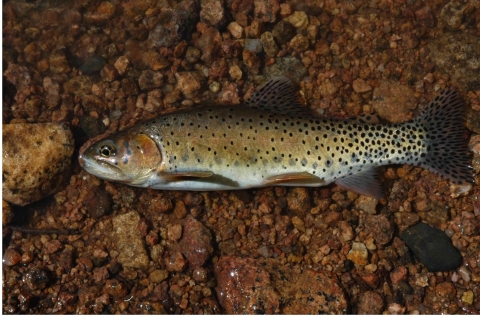The Colorado Fish and Wildlife Conservation Office is supportive of partnerships with universities to both meet programmatic requirements and to facilitate the progression of student experience in fisheries, wildlife, ecology and natural resources management. Our office has funded and supported graduate level research from a variety of universities including; Colorado State University, CSU-Pueblo, University of Colorado, University of Wyoming, Oklahoma State University, Fort Hayes State University, Kansas State University, University of Kansas, Idaho State University, and University of Minnesota. Here is a list of current and past research our office has supported:
An invasive species is any plant or animal that has spread or been introduced into a new area where they are, or could, cause harm to the environment, economy, or human, animal, or plant health. Their unwelcome presence can destroy ecosystems and cost millions of dollars.
Learn more about invasive species , were cut and placed along a cut bank to trap sediments, provide habitat for fish and wildlife, and reduce erosion. | Image Details
Colorado State University: Colorado Fish and Wildlife funded staff member Cole Brittain’s masters in Fish, Wildlife and Conservation Biology for studying how surface texture on a rock ramp fishway effects the passage success of small-bodied great plains fishes. Rock ramp fishways have been identified as a solution to stream fragmentation caused by in stream barriers throughout the Rocky Mountain and Great Plains ecosystems.
Oklahoma State University: Effects of riparian riparian
Definition of riparian habitat or riparian areas.
Learn more about riparian vegetative buffers on avian communities at McConnell Air Force Base and its potential to influence bird air strikes. This project compared bird community composition across riparian areas with and without buffers, and determined riparian buffers have potential to improve flight safety.
Kansas State University: Monitoring the effectiveness of redcedar revetments and documenting current stream conditions on McConnell Air Force Base. This project is analyzing the annual rate of erosion in McConnell Creek and how much sediment redcedar revetments will capture as well as how they improve macroinvertebrate community composition and water quality.
Fort Hayes State University: Identifying and monitoring the bats of McConnell Air Force Base. This project will sample the bat community through acoustic surveys, mist netting, and guano genetic analysis, as well as analyzing the diets of bat species on base.
University of Wyoming: Evaluating strategic weed management to reduce pesticide use and improve effectiveness on F.E. Warren Air Force Base. The goal of this project was to reduce invasive weeds on F.E. Warren Air Force Base and increase the productivity, diversity, and quality of desirable native vegetation to improve wildlife habitat and other ecosystems services.
Colorado State University – Pueblo:
- Movement patterns and resource use by lagomorphs, mesocarnivores, and scaled quail in Southeastern Colorado
- Predator prey interaction between raptors and dessert cottontail and raptors and scaled quail
- Impacts of population declines of prairie dogs on grassland ecosystems
- Improving methods of soft release for translocations of prairie dogs
- Impacts of translocations of prairie dogs to restore grassland habitat and long term monitoring of translocated prairie dogs
- Breeding biology of prairie songbirds
- Movement ecology, immunology and nasal micro biomes of ornate box turtles
- Associated publications:
- Peterson EK, Jones CD, Sandmeier FC, Arellano Rivas AP, Back CA, Canney A, Fender J, Gomez M, Gorski J, Heintzelman N, Healey K, Kester M, Klinger D, Liao A, Varian-Ramos CW, Vanden Heuvel B. (in revisions) Drought influences biodiversity in a semi-arid shortgrass prairie in southeastern Colorado. Journal of Arid Environments.
- Back C, Healey K, Staples SK, Peterson EK, Vanden Heuvel B. (2020) Natural history of plant species at the Pueblo Chemical Depot. El Rio, 1(1): 43-50).
Rocky Mountain National Park and Greenback Cutthroat Trout
Chris Kennedy is a fisheries biologist for the Colorado Fish and Wildlife Conservation Office who works in Rocky Mountain National Park. He serves as a fish historian for the park as well as the Leadville National Fish Hatchery. Researchers and graduate students from several universities have used his knowledge and experience with fish history, greenback cutthroat trout, and fisheries to assist and co-author multiple scientific papers and he has also published his own research. These publications include:
- Andrews, Thomas G. “An Environmental History of the Kawuneeche Valley and the Headwaters of the Colorado River, Rocky Mountain National Park.” (2011)
- Benjamin, J. R., and Baxter, C. V. “Is a trout a trout? A range-wide comparison shows nonnative brook trout exhibit greater density, biomass, and production than native inland cutthroat trout.” Biological Invasions, vol. 8, no. 1, 2006.
- Coleman, M. A., Fausch, K. D. “Causes of Recruitment Bottlenecks in Translocated Cutthroat Trout Populations: Investigation of Low Temperature Effects.” (2006)
- Eagles-Smith, C. A., et al. “Mercury in Fishes from 21 National Parks in the Western United States—Inter- and Intra-Park Variation in Concentrations and Ecological Risk.” (2014)
- Frank, J. J. “Marketing in the mountains: an environmental history of tourism in Rocky Mountain National Park.” (2008)
- Hermann, S. J. et al. “Differential Bioaccumulation of Mercury and Selenium in Stomach Contents and Tissues of Three Colorado, USA, Cutthroat Trout Populations.” Bulletin of Environmental Contamination and Toxicology, 104:595–601, 2020.
- Hermann, S. J. et al. “Mercury and Selenium in Twelve Cutthroat Trout Tissues from High-Elevation Colorado Lakes, USA: Intraspecific and Interspecific Comparisons.” Transactions of the American Fisheries Society, 147:444–458, 2018.
- Kennedy, C. M., “Weird Bear Creek: A History of a Unique Cutthroat Trout Population.” (2010)
- Lafrancois, Toben. “A survey of the impacts of fish introduction and removal on zooplankton of alpine lakes in Rocky Mountain National Park, USA.” (2005).
- Love Stowell, S. M. “Evolution and Conservation of cutthroat trout (Oncorhynchus clarkii spp.) in the southern rocky mountains.” (2011).
- Love Stowell, S. M., et al. “The genetic legacy of more than a century of stocking trout: a case study in Rocky Mountain National Park, Colorado, USA.” Canadian Journal of Fisheries and Aquatic Sciences, vol. 72, 2015.
- McGrath, C. C., Lewis, W. M. Jr. “Competition and Predation as Mechanisms for Displacement of Greenback Cutthroat Trout by Brook Trout.” Transactions of the American Fisheries Society, 136:1381-1392, 2007.
- Metcalf, J. L., et. Al. “Historical stocking data and 19th century DNA reveal human-induced changes to native diversity and distribution of cutthroat trout.” Molecular Ecology, 2012.
- Myrick, C., and Kondratieff, M., “An evaluation of a potential barrier to the upstream movement of brook trout in Rocky Mountain National Park, Colorado.” (2004)
- Neville, H. M., and Bernatchez, L. “Coding Gene Single Nucleotide Polymorphism Population Genetics of Nonnative Brook Trout: The Ghost of Introductions Past.” Transactions of the American Fisheries Society, 2013.
- Roberts, J. J., et al. “Thermal regimes of rocky mountain lakes warm with climate change climate change
Climate change includes both global warming driven by human-induced emissions of greenhouse gases and the resulting large-scale shifts in weather patterns. Though there have been previous periods of climatic change, since the mid-20th century humans have had an unprecedented impact on Earth's climate system and caused change on a global scale.
Learn more about climate change .” PLoS ONE, vol. 12, no. 7, 2017. - Young, M. K., et al. “Recovery history of greenback cutthroat trout: population characteristics, hatchery involvement and bibliography.” (2002).













